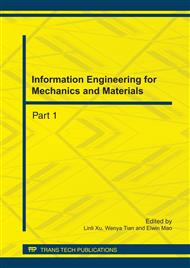[1]
E. Masayoshi, O. Takahito, MEMS/NEMS by Micro Nanomachining, IEIC Tech. Rep. 103 (2003) 13-18.
Google Scholar
[2]
H.W. Schumacher, U.F. keyser, U. Zeitler, R.J. Haug, K. Ebert, Controlled mechanical AFM machining of two-dimensional electron systems: fabrication of a single-electron transistor, Physica E, 6 (2000) 860-863.
DOI: 10.1016/s1386-9477(99)00230-1
Google Scholar
[3]
S. Shimada, N. Ikawa, H. Tanaka, J. Uchikoshi, Structure of micromachined surface simulated by molecular dynamics analysis, CIRP Annals, 43 (1994) 51-54.
DOI: 10.1016/s0007-8506(07)62162-3
Google Scholar
[4]
R. Komanduri, N. Chandrasekaran, L.M. Raff, MD simulation of indentation and scratching of single crystal aluminum, Wear, 240 (2000) 113- 143.
DOI: 10.1016/s0043-1648(00)00358-6
Google Scholar
[5]
R. Komanduri, N Chandrasekaran, L. M Raff, Molecular dynamics simulation of atomic-scale friction, Phys. Rev. B, 2000, 61: 14007-14019.
DOI: 10.1103/physrevb.61.14007
Google Scholar
[6]
Q.X. Pei, C. Lu, H.P. Lee, Large scale molecular dynamics study of nanometric machining of copper, Comput. Mater. Sci. 41 (2007) 177-185.
DOI: 10.1016/j.commatsci.2007.04.008
Google Scholar
[7]
Q.X. Pei, C. Lu, H.P. Lee, Y.W. Zhang, Study of materials deformation in nanometric cutting by large-scale molecular dynamics simulations, Nanoscale Res. Lett. 4 (2009) 441-451.
DOI: 10.1007/s11671-009-9268-z
Google Scholar
[8]
D. Mulliah, D. Christopher, S.D. Kenny, R. Smith, Nanoscratching of silver (100) with a diamond tip, Nucl. Instrum. Meth. B, 202 (2003) 294-299.
DOI: 10.1016/s0168-583x(02)01872-4
Google Scholar
[9]
R. Smith, D. Mulliah, S.D. Kenny, E. McGee, A. Richter, M. Gruner, Stick slip and wear on metal surfaces, Wear, 259 (2005) 459–466.
DOI: 10.1016/j.wear.2005.01.023
Google Scholar
[10]
J.X. Chen, Y.C. Liang, Q.S. Bai, Y.L. Tang, M.J. Chen, Reseaching Nanometric Cutting of Copper Based On Molecular Dynamics, J. Comput. Theor. Nanosci. 5 (2008) 1485-1489.
Google Scholar
[11]
Y.C. Liang, J.X. Chen, M.J. Chen, Y.L. Tang and, Q.S. Bai, Integrated MD simulation of scratching and shearing of 3D nanostructure, Comput. Mater. Sci. 43 (2008) 1130-1140.
DOI: 10.1016/j.commatsci.2008.03.012
Google Scholar
[12]
Z.C. Lin, J.C. Huang, A nano-orthogonal cutting model based on a modified molecular dynamics technique, Nanotechnology, 15 (2004) 510-519.
DOI: 10.1088/0957-4484/15/5/019
Google Scholar
[13]
R.A. Johnson, Analytic nearest-neighbor model for fcc metals Phys. Rev. B, 37 (1988) 3924-3631.
DOI: 10.1103/physrevb.37.3924
Google Scholar
[14]
R.A. Johnson, Alloy models with the embedded-atom method, Phys. Rev. B, 39 (1989) 12554-12559.
DOI: 10.1103/physrevb.39.12554
Google Scholar
[15]
Y.C. Liang, J.X. Chen, Q.S. Bai, D.P. Song and M.J. Chen, 3D molecular dynamics simulation of nanostructure for reciprocating nanomachining process, J. Vac. Sci. Technol. B, 27 (2009) 1536-1542.
DOI: 10.1116/1.3110027
Google Scholar


